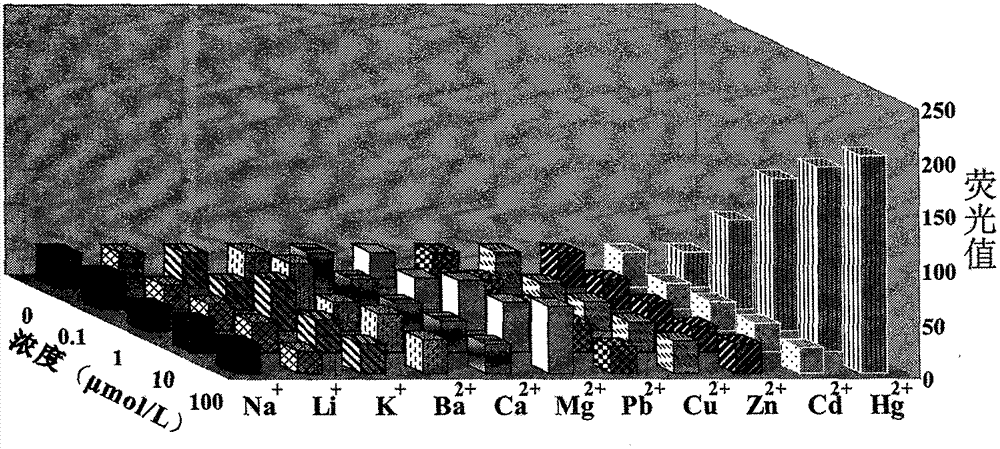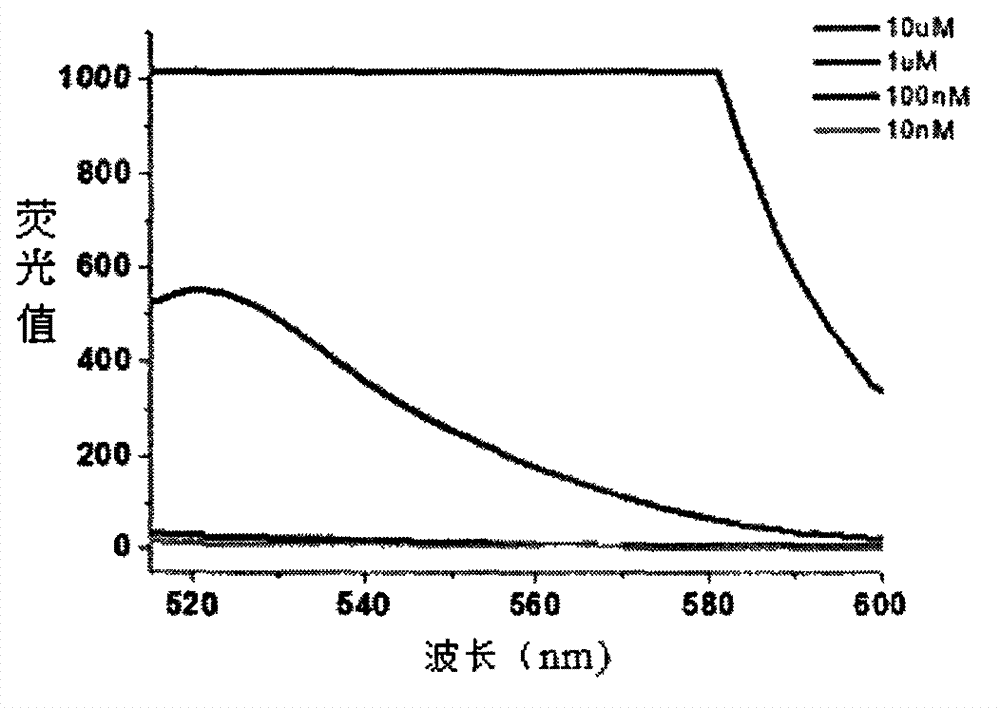Mercury ion fluorescence detection method and kit
A fluorescence detection, mercury ion technology, applied in the direction of fluorescence/phosphorescence, material excitation analysis, etc., can solve the problems of poor selectivity, poor water solubility of the sensor, slow response speed, etc., and achieve the effect of low cost, short sequence and small response
- Summary
- Abstract
- Description
- Claims
- Application Information
AI Technical Summary
Problems solved by technology
Method used
Image
Examples
Embodiment 1
[0033] Example 1 Fluorescence-labeled and non-fluorescent-labeled MSO dosage optimization design
[0034]Take 2.5 μl of different concentrations (10nM, 100nM, 1μM, 10μM) of fluorescein (FAM)-labeled and non-fluorescent-labeled MSO, add 265μl of 20mM Tris-HCl buffer, react at room temperature for 5 minutes, and use RF-5301PC fluorescence spectrometry The photometer scans the fluorescence wavelength curve. Fluorescence spectrum measurement conditions of the fluorescence spectrophotometer: xenon lamp excitation, slit width 10nm, response time Auto. The excitation wavelength is 496nm, and the scanning range of the emission spectrum is 515-600nm. The measurement is performed at room temperature with a 350μL microcuvette, and the fluorescence value at 522nm is recorded. The fluorescence values at 522nm of different concentrations of fluorescently labeled MSO were recorded for comparison. The result is as figure 1 : When the concentration of fluorescently labeled and non-fluores...
Embodiment 2
[0035] Embodiment 2 buffer optimization design
[0036] Prepare Tris-HCl buffer containing metal ions and Tris-HCl buffer without metal ions. After taking 2.5 μl of 1 μM fluorescently-labeled and non-fluorescently-labeled MSO, these two buffers were added to scan the fluorescence wavelength curve, and the fluorescence value at a wavelength of 522 nm was recorded. Finally, 5 μl of 0.5 g / L GO was added, reacted at room temperature for 5 minutes, and then scanned the fluorescence wavelength to record the change of fluorescence value. figure 2 Among them, when the Tris-HCl buffer containing metal ions was added to the reaction system, the fluorescence quenching efficiency reached (55.191±5.4)% on average before and after adding GO, which was relatively stable; when the Tris-HCl buffer containing no metal ions solution was added to the reaction system, before and after adding GO, the fluorescence quenching efficiency reached (10.108±2.2)% on average, which was much lower than the...
Embodiment 3
[0037] Embodiment 3GO and Hg 2+ Exploring the sequence of adding samples
[0038] After taking 2.5 μl of 1 μM fluorescently labeled and unfluorescently labeled MSO, first add 5 μl of 0.5 g / L GO, 265 μl of 20 mM Tris-HCl buffer, and then add Hg 2+ and add Hg first 2+ , 265μl of 20mM Tris-HCl buffer solution, and then add 5μl of 0.5g / LGO in these two ways for time kinetic detection, continuous detection for 15 minutes, and observe the change of fluorescence intensity. At the same time, each group uses water group as the control group. The optimal sequence of adding samples for the detection of mercury ions by fluorescence method. from image 3 The results showed that adding GO first and then adding Hg 2+ The signal-to-noise ratio of the group increases with the prolongation of time, and the S / N at 15 minutes can reach 1.476±0.123, indicating that after adding mercury ions, the fluorescence does recover, and the experimental results are better than adding Hg 2+ Add GO group ...
PUM
 Login to View More
Login to View More Abstract
Description
Claims
Application Information
 Login to View More
Login to View More - R&D
- Intellectual Property
- Life Sciences
- Materials
- Tech Scout
- Unparalleled Data Quality
- Higher Quality Content
- 60% Fewer Hallucinations
Browse by: Latest US Patents, China's latest patents, Technical Efficacy Thesaurus, Application Domain, Technology Topic, Popular Technical Reports.
© 2025 PatSnap. All rights reserved.Legal|Privacy policy|Modern Slavery Act Transparency Statement|Sitemap|About US| Contact US: help@patsnap.com



